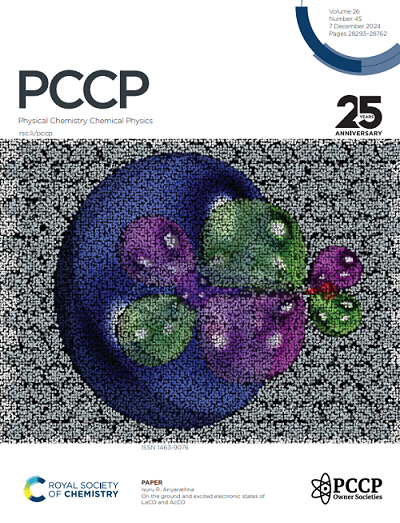Effect of Halogen Substitution in Spacer Cations on Two-Dimensional Ruddlesden-Popper Perovskites
IF 2.9
3区 化学
Q3 CHEMISTRY, PHYSICAL
引用次数: 0
Abstract
This research investigated how halogen substitution in spacer cations influenced the crystal and electronic structures of two-dimensional Ruddlesden-Popper perovskites (X-(CH2)2-NH3)2PbI4 (where X can be I, Br, or Cl) through first-principles calculations. In contrast to (I-(CH2)2-NH3)2PbI4, (Br-(CH2)2-NH3)2PbI4 and (Cl-(CH2)2-NH3)2PbI4 exhibited a greater degree of deviation from ideal octahedral geometry. Moreover, the Pb-I-Pb bond angles in (Br-(CH2)2-NH3)2PbI4 and (Cl-(CH2)2-NH3)2PbI4 were approximately 180°, indicating that the distortions of the adjacent [PbI6]4- octahedra were relatively minor. In comparison, (I-(CH2)2-NH3)2PbI4 demonstrated more significant adjacent [PbI6]4- octahedral distortions and therefore larger band gap. The significant distortion of adjacent [PbI6]4- octahedra in (I-(CH2)2-NH3)2PbI4 was found to predominantly induced by hydrogen-bonding interactions between the organic and inorganic components, along with the I-I interactions. In (Br-(CH2)2-NH3)2PbI4 and (Cl-(CH2)2-NH3)2PbI4, the hydrogen-bonding interactions between the spacer cations facilitated the insertion of two carbon atoms into the pocket of the inorganic layer, leading to significant distortion of the individual [PbI6]4- octahedra. Additionally, these hydrogen-bonding interactions significantly contributed to their increased thermal stability. Moreover, the symmetrical positioning of the spacer cations in relation to the inorganic layer led to symmetrical hydrogen-bonding interactions between the organic and inorganic components, which helped prevent the deformation of adjacent [PbI6]4- octahedra. This research provided valuable theoretical insights for the selection of organic cations of two-dimensional organic-inorganic hybrid materials.求助全文
约1分钟内获得全文
求助全文
来源期刊

Physical Chemistry Chemical Physics
化学-物理:原子、分子和化学物理
CiteScore
5.50
自引率
9.10%
发文量
2675
审稿时长
2.0 months
期刊介绍:
Physical Chemistry Chemical Physics (PCCP) is an international journal co-owned by 19 physical chemistry and physics societies from around the world. This journal publishes original, cutting-edge research in physical chemistry, chemical physics and biophysical chemistry. To be suitable for publication in PCCP, articles must include significant innovation and/or insight into physical chemistry; this is the most important criterion that reviewers and Editors will judge against when evaluating submissions.
The journal has a broad scope and welcomes contributions spanning experiment, theory, computation and data science. Topical coverage includes spectroscopy, dynamics, kinetics, statistical mechanics, thermodynamics, electrochemistry, catalysis, surface science, quantum mechanics, quantum computing and machine learning. Interdisciplinary research areas such as polymers and soft matter, materials, nanoscience, energy, surfaces/interfaces, and biophysical chemistry are welcomed if they demonstrate significant innovation and/or insight into physical chemistry. Joined experimental/theoretical studies are particularly appreciated when complementary and based on up-to-date approaches.
 求助内容:
求助内容: 应助结果提醒方式:
应助结果提醒方式:


